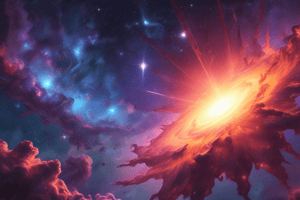Podcast
Questions and Answers
What is the initial stage of star formation called?
What is the initial stage of star formation called?
- White Dwarf
- Nebula (correct)
- Main Sequence Star
- Protostar
A protostar is a hot ball of gas that has begun nuclear fusion reactions.
A protostar is a hot ball of gas that has begun nuclear fusion reactions.
False (B)
What process occurs within the core of a main-sequence star?
What process occurs within the core of a main-sequence star?
Nuclear fusion
A low-mass star will eventually become a _______ after the red giant stage.
A low-mass star will eventually become a _______ after the red giant stage.
Match the following terms with their definitions:
Match the following terms with their definitions:
What stage does a low-mass star become after the hydrogen fusion reactions decrease?
What stage does a low-mass star become after the hydrogen fusion reactions decrease?
The core of a high-mass star will eventually transform into a black hole if it collapses sufficiently.
The core of a high-mass star will eventually transform into a black hole if it collapses sufficiently.
What is the ejected outer layer of a dying star called?
What is the ejected outer layer of a dying star called?
A high-mass star will become a red __________ after hydrogen fusion reactions begin to cease.
A high-mass star will become a red __________ after hydrogen fusion reactions begin to cease.
Match the following stages of a star's life cycle with their descriptions:
Match the following stages of a star's life cycle with their descriptions:
What happens when a red supergiant cannot continue fusion?
What happens when a red supergiant cannot continue fusion?
A black dwarf is the end stage of a white dwarf after it has lost significant energy.
A black dwarf is the end stage of a white dwarf after it has lost significant energy.
What element can fusion reactions in a high-mass star continue to form until?
What element can fusion reactions in a high-mass star continue to form until?
A dense body formed at the center of a supernova is called a __________.
A dense body formed at the center of a supernova is called a __________.
Match the following types of stars with their mass categories:
Match the following types of stars with their mass categories:
Flashcards are hidden until you start studying
Study Notes
Star Formation
- Stars originate from a nebula, a vast interstellar cloud composed of hydrogen gas and dust.
- Gravity causes particles in the nebula to aggregate, forming a protostar, characterized by increased density and temperature due to frequent particle collisions.
Main Sequence Star
- A protostar evolves into a main-sequence star when nuclear fusion begins, fusing hydrogen nuclei into helium and releasing heat and light.
- At this stage, the star achieves hydrostatic equilibrium where gravitational forces are balanced by the outward pressure from fusion reactions.
- The star's future trajectory depends on its mass, leading to different life cycles.
Life Cycle of a Low-Mass Star
- A low-mass star (up to 8 solar masses) transitions into a red giant as hydrogen fusion decreases after billions of years.
- The core shrinks and heats up, initiating helium fusion, leading to an expansion of the outer layers resulting in a red giant appearance.
- Once helium fusion ends, the star ejects its outer layers, forming a planetary nebula.
- The core remnant becomes a white dwarf, gradually cooling and diminishing in energy output until it turns into a black dwarf, eventually fading from visibility.
Life Cycle of a High-Mass Star
- High-mass stars (greater than 8 solar masses) evolve into red supergiants after a few million years as hydrogen fusion wanes.
- Similar to low-mass stars, the core undergoes periods of contraction and expansion, forming heavier elements up to iron.
- The inevitable end of fusion in a red supergiant leads to a supernova, a colossal explosion that ejects outer layers and creates a dense neutron star at the core.
- The neutron star may further collapse into a black hole, an extremely dense region from which not even light can escape.
Additional Insights
- The nebula formed from supernova remnants can lead to the birth of new stars and planetary systems.
- The process of fusion reactions is crucial for a star's stability, influencing its structure and eventual fate.
Studying That Suits You
Use AI to generate personalized quizzes and flashcards to suit your learning preferences.




